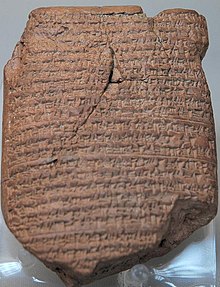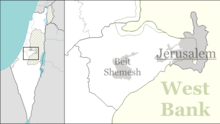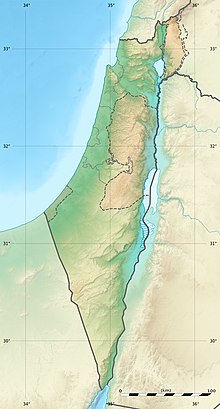| Revision as of 09:38, 17 November 2023 editCitation bot (talk | contribs)Bots5,457,867 edits Alter: pages. Add: publisher, pages, date. Removed parameters. Formatted dashes. | Use this bot. Report bugs. | Suggested by DiverDave | #UCB_toolbar← Previous edit | Revision as of 01:37, 28 January 2024 edit undoOctoGreeko (talk | contribs)523 editsmNo edit summaryTags: Reverted Visual edit Mobile edit Mobile web editNext edit → | ||
| Line 3: | Line 3: | ||
| {{other uses|Siege of Jerusalem (disambiguation){{!}}Siege of Jerusalem}} | {{other uses|Siege of Jerusalem (disambiguation){{!}}Siege of Jerusalem}} | ||
| {{Infobox military conflict | {{Infobox military conflict | ||
| |image = ABC 05 Early Years of Nebuchadnezzar chronicle.jpg | | image = ABC 05 Early Years of Nebuchadnezzar chronicle.jpg | ||
| |caption = The siege of Jerusalem is mentioned in the ] (ABC 05) | | caption = The siege of Jerusalem is mentioned in the ] (ABC 05) | ||
| |conflict = Siege of Jerusalem | | conflict = Siege of Jerusalem | ||
| |partof = ] (601–587 BC) | | partof = ] (601–587 BC) | ||
| |date = {{circa}} 597 BC | | date = {{circa}} 597 BC | ||
| |place = ] | | place = ] | ||
| | coordinates = {{WikidataCoord|display=it}} | | coordinates = {{WikidataCoord|display=it}} | ||
| | map_type = Israel jerusalem#Israel | | map_type = Israel jerusalem#Israel | ||
| | map_relief = y | | map_relief = y | ||
| | map_size = | | map_size = | ||
| | map_marksize = | | map_marksize = | ||
| | map_caption = | | map_caption = | ||
| | map_label = | | map_label = | ||
| | map_mark = | | map_mark = | ||
| | casus = | | casus = | ||
| | territory = | | territory = | ||
| |result = Babylonian victory |
| result = Babylonian victory | ||
| *Babylon takes and despoils Jerusalem | |||
| |combatant1 = ] | | combatant1 = ] | ||
| |combatant2 = ] |
| combatant2 = ] | ||
| |commander1 = ] {{KIA}}<br/>] | | commander1 = ] {{KIA}}<br/>] | ||
| |commander2 = ] | | commander2 = ] | ||
| |strength1 = Much fewer | | strength1 = Much fewer | ||
| |strength2 = Unknown | | strength2 = Unknown | ||
| |casualties1 = Many slain, others taken to captivity | | casualties1 = Many slain, others taken to captivity | ||
| |casualties2 = Unknown}} | | casualties2 = Unknown | ||
| }} | |||
| {{Campaignbox Campaigns of Nebuchadnezzar II}} | {{Campaignbox Campaigns of Nebuchadnezzar II}} | ||
| {{Jerusalem sidebar}} | {{Jerusalem sidebar}} | ||
Revision as of 01:37, 28 January 2024
Victory by Nebuchadnezzar II of Babylon This article is about the siege that occurred in 597 BC. Not to be confused with the second siege by Nebuchadnezzar, see Siege of Jerusalem (587 BC). For other uses, see Siege of Jerusalem.| Siege of Jerusalem | |||||||
|---|---|---|---|---|---|---|---|
| Part of Judah's revolts against Babylon (601–587 BC) | |||||||
 The siege of Jerusalem is mentioned in the Early Years of Nebuchadnezzar chronicle (ABC 05) | |||||||
| |||||||
| Belligerents | |||||||
| Judah | Neo-Babylonian Empire | ||||||
| Commanders and leaders | |||||||
|
Jehoiakim † Jeconiah | Nebuchadnezzar II | ||||||
| Strength | |||||||
| Much fewer | Unknown | ||||||
| Casualties and losses | |||||||
| Many slain, others taken to captivity | Unknown | ||||||
  | |||||||
| Campaigns of Nebuchadnezzar II | |
|---|---|
| Part of a series on | ||||||||||||||||||||
| Jerusalem | ||||||||||||||||||||
|---|---|---|---|---|---|---|---|---|---|---|---|---|---|---|---|---|---|---|---|---|
 | ||||||||||||||||||||
|
||||||||||||||||||||
Sieges
|
||||||||||||||||||||
| Places | ||||||||||||||||||||
|
|
||||||||||||||||||||
| Political status | ||||||||||||||||||||
| Other topics | ||||||||||||||||||||
The siege of Jerusalem (597 BC) was a military campaign carried out by Nebuchadnezzar II, king of the Neo-Babylonian Empire, in which he besieged Jerusalem, then capital of the Kingdom of Judah. The city surrendered, and its king Jeconiah was deported to Babylon and replaced by his Babylonian-appointed uncle, Zedekiah. The siege is recorded in both the Hebrew Bible (2 Kings 24:10–16) and the Babylonian Nebuchadnezzar Chronicle.
In 601 BC, Nebuchadnezzar II unsuccessfully attempted to take Egypt and was repulsed with heavy losses. Jehoiakim—the king of Judah—seized this opportunity to revolt against Babylonian rule, taking a pro-Egyptian position, despite the strong remonstrances of the prophet Jeremiah. The circumstances of Jehoiakim’s death are not clear. He was succeeded by his young son, Jeconiah.
The Babylonians besieged Jerusalem, and in March 597 BC the city surrendered. Jeconiah, his court and other prominent citizens and craftsmen, were deported to Babylon. This event is considered to be the start of the Babylonian captivity and of the Jewish diaspora. Jeconiah's uncle, Zedekiah, was installed as vassal king of Judah.
A decade later, Zedekiah launched another rebellion against the Babylonians, which was brutally crushed by Nebuchadnezzar II. In 587 BC, a second siege of Jerusalem culminated in the destruction of the city and Solomon's Temple, bringing an end to the Kingdom of Judah.
Dating
The Babylonian Chronicles, which were published by Donald Wiseman in 1956, establish that Nebuchadnezzar captured Jerusalem the first time on March 16, 597 BC. Before Wiseman's publication, E. R. Thiele had determined from the biblical texts that Nebuchadnezzar's initial capture of Jerusalem occurred in the spring of 597 BC, but other scholars, including William F. Albright, more frequently dated the event to 598 BC.
Siege
To avoid the destruction of Jerusalem, King Jehoiakim of Judah, in his third year, changed his allegiance from Egypt to Babylon. He paid tribute from the treasury in Jerusalem, and Nebuchadnezzar took some temple artifacts and some of the royal family and nobility as hostages. In 601 BC, during the fourth year of his reign, Nebuchadnezzar unsuccessfully attempted to invade Egypt and was repulsed with heavy losses. The failure led to numerous rebellions among the states of the Levant which owed allegiance to Babylon, including Judah, where King Jehoiakim stopped paying tribute to Nebuchadnezzar and took a pro-Egyptian position.
Nebuchadnezzar soon dealt with these rebellions. According to the Nebuchadnezzar Chronicle, he laid siege to Jerusalem, which eventually fell in 597 BC. The Chronicle states:
In the seventh year in the month Chislev the king of Babylon assembled his army, and after he had invaded the land of Hatti (Syria/Palestine) he laid siege to the city of Judah. On the second day of the month of Adar he conquered the city and took the king prisoner. He installed in his place a king of his own choice, and after he had received rich tribute, he sent forth to Babylon.
Jehoiakim died during the siege, possibly on December 10, 598 BC, or during the months of Kislev, or Tevet. Nebuchadnezzar pillaged the city and its Temple, and the new king Jeconiah, who was either 8 or 18, and his court and other prominent citizens and craftsmen, were deported to Babylon. The deportation occurred prior to Nisan of 597 BC, and dates in the Book of Ezekiel are counted from that event.
Nebuchadnezzar installed Jeconiah's uncle, Zedekiah as puppet-king of Judah, and Jeconiah was compelled to remain in Babylon. The start of Zedekiah's reign has been variously dated within a few weeks before, or after the start of Nisan 597 BC.
The Book of Kings (written in the 7th and 6th centuries BC) records that 10,000 people were exiled during this time, also adding 7,000 craftsmen and 1,000 "smiths", bringing the total to 18,000. Comparatively, the Book of Jeremiah mentions 3,023 people taken into captivity. Some scholars have argued whether this number includes only men. If this is true, perhaps as many as 15,000 to 30,000 Judeans were exiled.
References
- ^ Bickerman, E. J. (January 2007). Nebuchadnezzar And Jerusalem. Brill. pp. 961–974. ISBN 978-90-474-2072-9.
- Malamat, A. (1975, January). The twilight of Judah: in the Egyptian-Babylonian maelstrom. In Congress Volume Edinburgh 1974 (pp. 123-145). Brill.
- ^ The Divided Monarchy c. 931–586 BC
- Smit, E. J. (1994). "So how did Jehoiakim die?". Journal for Semitics. 6 (1): 46–56. hdl:10520/AJA10318471_285.
- Begg, C. (1996). "The end of King Jehoiakim: the afterlife of a problem". Journal for Semitics. 8 (1): 12–20. doi:10.10520/AJA10318471_366 (inactive 1 August 2023).
{{cite journal}}: CS1 maint: DOI inactive as of August 2023 (link) - ^ The Oxford History of the Biblical World, ed. by Michael D Coogan. Published by Oxford University Press, 1999. pg 350
- D. J. Wiseman, Chronicles of Chaldean Kings in the British Museum (London: Trustees of the British Museum, 1956) 73.
- Edwin Thiele, The Mysterious Numbers of the Hebrew Kings, (1st ed.; New York: Macmillan, 1951; 2d ed.; Grand Rapids: Eerdmans, 1965; 3rd ed.; Grand Rapids: Zondervan/Kregel, 1983). ISBN 0-8254-3825-X, 9780825438257, 217.
- Kenneth Strand, "Thiele's Biblical Chronology As a Corrective for Extrabiblical Dates," Andrews University Seminary Studies 34 (1996) 310, 317.
- C. Hassell Bullock (May 2007). An Introduction to the Old Testament Prophetic Books. Moody Publishers. p. 340. ISBN 9781575674360.
- Geoffrey Wigoder, The Illustrated Dictionary & Concordance of the Bible Pub. by Sterling Publishing Company, Inc. (2006)
- No 24 WA21946, The Babylonian Chronicles, The British Museum
- Horn, Siegfried H. (1967). "The Babylonian Chronicle and the Ancient Calendar of the Kingdom of Judah" (PDF). Andrews University Seminary Studies. V (1): 21.
- Lipschits, Oded (2002). "'Jehoiakim Slept with his Fathers...' (II Kings 24:6) – Did He?". Journal of Hebrew Scriptures. 4: 23. doi:10.5508/jhs.2002.v4.a1. ISSN 1203-1542.
- Green, Alberto R. (1982). "The fate of Jehoiakim". Andrews University Seminary Studies. 20 (2): 106. Archived from the original (pdf) on 2016-03-04. Retrieved 2014-12-17.
- Young, Rodger C. (March 2004). "When Did Jerusalem Fall?" (PDF). Journal of the Evangelical Theological Society. 47 (1): 32ff.
- Britannica.com, Zedekiah
- Thompson, John Arthur (1980). The Book of Jeremiah. Wm. B. Eerdmans Publishing. p. 729.
- Hayes, John H.; Hooker, Paul K. (2007). A New Chronology for the Kings of Israel and Judah and Its Implications for Biblical History and Literature. Wipf and Stock Publishers. p. 95.
- Thiele, Edwin R. (1970). The Mysterious Numbers of the Hebrew Kings. Kregel Academic. p. 192.
- 2 Kings 24:14
- 2 Kings 24:16
- ^ Smith-Christopher, D. L. (1997-01-01), "Reassessing the Historical and Sociological Impact of the Babylonian Exile", Exile: Old Testament, Jewish, and Christian Conceptions, BRILL, pp. 7–21, doi:10.1163/9789004497719_008, S2CID 244932444, retrieved 2022-05-24
- Jeremiah 52:28
External links
- The Siege on the Encyclopædia Britannica website
- The Chronicle Concerning the Early Years of Nebuchadnezzar II Archived 2019-05-05 at the Wayback Machine
| Second Book of Kings | |||||||||
|---|---|---|---|---|---|---|---|---|---|
| Bible chapters | |||||||||
| Places | |||||||||
| Persons |
| ||||||||
| Phrases/events | |||||||||
| Textual analysis | |||||||||
| Sources | |||||||||
| The Bible and warfare | ||||||||||||
|---|---|---|---|---|---|---|---|---|---|---|---|---|
| Hebrew Bible battles |
|  | ||||||||||
| Bible Portal | ||||||||||||